Honoring the Ultimate Sacrifice: The Sacred Journey Home
A dignified transfer is the solemn process by which the remains of fallen U.S. military service members are transported from the aircraft to a transfer vehicle at Dover Air Force Base, Delaware. This formal movement honors those who have made the ultimate sacrifice in service to their country.
What is a Dignified Transfer?
- Definition: A solemn movement (not a ceremony) of remains from aircraft to vehicle
- Location: Primarily conducted at Dover Air Force Base, Delaware
- Who receives it: Every U.S. service member who dies in a theater of operations
- Duration: Approximately 15 minutes
- Key participants: Service-specific carry team, senior officer, and family (if they choose)
The Department of Defense ensures that each fallen service member is returned to American soil with dignity, honor, and respect. The process typically includes a stop at Ramstein Air Base in Germany before the final leg to Dover AFB, where a carefully choreographed transfer takes place.
Since 2009, media coverage has been permitted only with family consent, balancing public transparency with family privacy during this deeply personal time.
I'm Mortuary Cooler, a national supplier of mortuary equipment supporting the dignified transfer process through proper temperature-controlled storage solutions that maintain the integrity and dignity of fallen heroes.
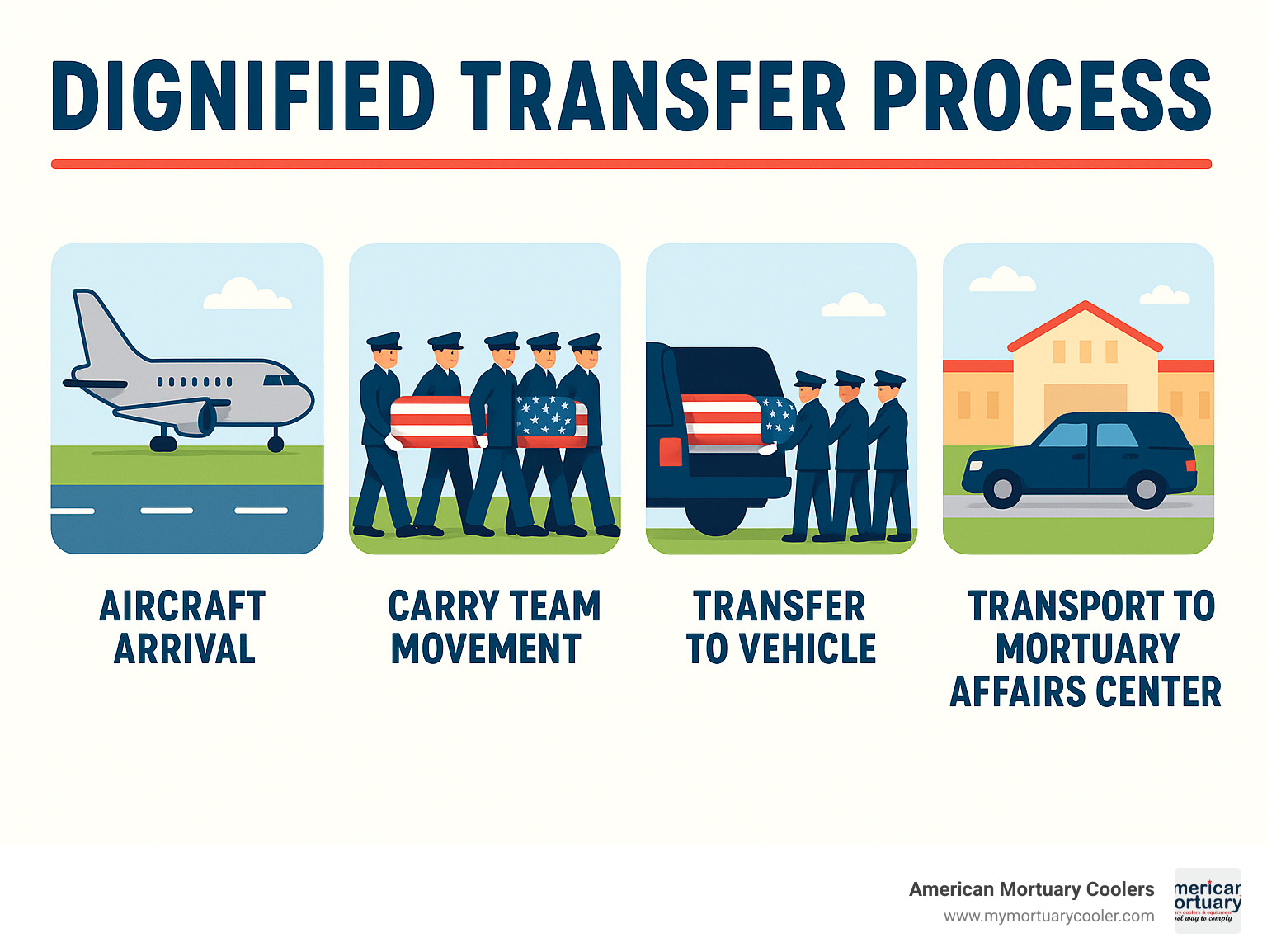
Dignified transfer word roundup:
What Is a Dignified Transfer? Purpose & Principles
A dignified transfer isn't a ceremony in the traditional sense but a solemn movement honoring fallen heroes with quiet reverence. The Department of Defense defines it as the careful transfer of a fallen service member's remains from the arriving aircraft to a waiting vehicle, which then proceeds to the mortuary facility.
At its heart, the dignified transfer fulfills the military's sacred obligation: bringing America's fallen home to their families quickly while maintaining absolute dignity. The American flag draped over each transfer case symbolizes the nation's final accept of the service member.
What distinguishes these transfers is the presence of a senior ranking officer from the fallen member's branch of service, representing the military's acknowledgment of sacrifice at its highest levels.
These principles align with broader concepts of dignity in care. Research from the Social Care Institute for Excellence shows that true dignity means supporting a person's self-respect and recognizing their value—principles that extend into how we care for them after death.
At American Mortuary Coolers, our Tennessee-made equipment supports the solemn work that follows the transfer, ensuring remains are preserved with respect.
Historical Evolution of the Dignified Transfer
The way America welcomes home its fallen has evolved significantly. From 1991 until 2009, a complete media blackout shrouded these arrivals at Dover Air Force Base, preventing photographs or video of flag-draped transfer cases.
In 2009, Defense Secretary Robert Gates announced a thoughtful compromise: media could document these solemn homecomings, but only with explicit permission from the fallen service member's family. This balanced the public's right to understand war's human cost with the family's right to privacy.
Air Force Staff Sergeant Phillip Myers became the first fallen service member received under this new policy in April 2009. Since then, these quiet homecomings occasionally capture national attention, especially when presidents attend.
Presidents Obama, Trump, and Biden have all stood on the tarmac at Dover, bringing momentary public focus to this otherwise private ritual.
Core Principles of Dignity in Post-Mortem Care
The dignified transfer embodies fundamental principles guiding the care of fallen service members:
Respect forms the foundation—treating the deceased with the same reverence shown in life.
Autonomy means honoring the service member's known wishes and respecting family decisions.
Privacy remains paramount throughout the process, with careful attention to confidentiality.
Cultural Sensitivity ensures diverse religious and cultural traditions are honored.
The Platinum Rule takes things further than the Golden Rule—treating others as they would want to be treated, with care customized to individual beliefs.
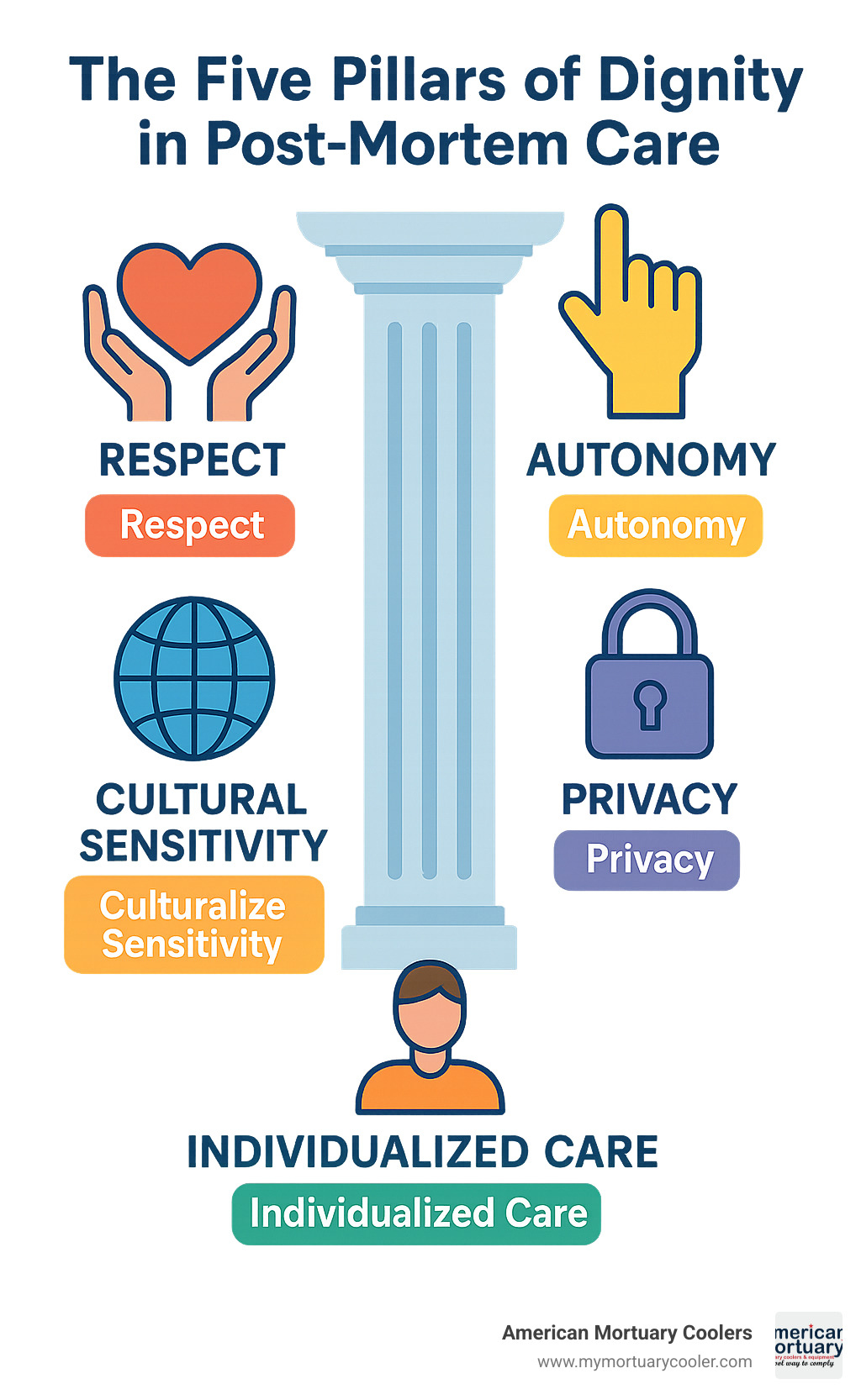
Step-by-Step Process at Dover Air Force Base
When a fallen hero returns to American soil, a carefully orchestrated dignified transfer unfolds at Dover Air Force Base. This solemn process lasts just 15 minutes but represents a profound moment of respect and honor.
The journey begins as the aircraft carrying our fallen hero touches down at Dover. Ground crews work with quiet efficiency, opening the cargo door and positioning equipment with practiced precision.
A carry team assembles nearby—service members from the same branch as the fallen who've trained extensively for this honored duty. As the flag-draped transfer case appears, a hush falls over the scene. Every military member renders a crisp salute. The carry team approaches with measured steps, lifting the transfer case and carrying it to the waiting vehicle.
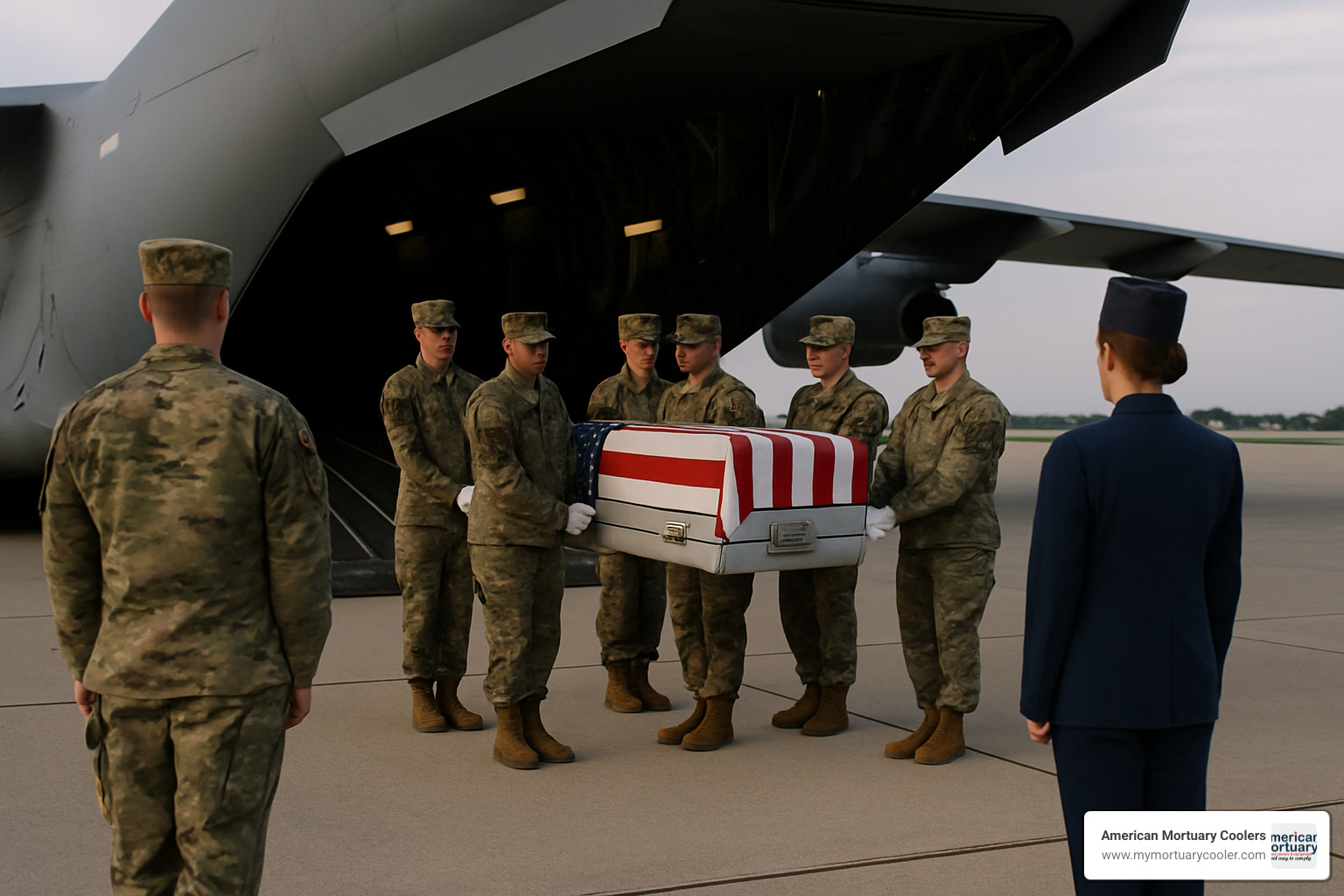
Overseeing this movement stands a senior officer from the fallen member's service branch. Once secured in the vehicle, the transfer case makes the short journey to the Charles C. Carson Center for Mortuary Affairs for identification.
For families who choose to witness this homecoming, the Fisher House at Dover provides a comfortable haven during this difficult time.
Aircraft Arrival & Carry Team Movement
The arrival of an aircraft carrying fallen service members creates a moment where time seems to stand still. These flights typically arrive after stopping at Ramstein Air Base in Germany.
As the aircraft comes to rest, the flight line takes on a solemn quality. The carry team—six to eight service members from the same branch as the fallen hero—assembles nearby. A Marine carries a Marine home; a Soldier carries a Soldier.
Their march to the aircraft unfolds with precision born of countless hours of practice. As the flag-draped transfer case appears, all military personnel render a salute. The carry team ascends to receive their fallen comrade, lifting the transfer case with careful coordination and carrying it to the waiting vehicle.
Throughout this process, no word is spoken unnecessarily. The power of the moment lies in its quiet dignity.
Family Attendance & Viewing Options
The Department of Defense provides funding for up to three family members to travel to Dover Air Force Base—typically the primary next of kin and two additional family members.
Families won't view their loved one's remains during this process. Instead, they witness the solemn movement of the flag-draped transfer case, as positive identification hasn't yet been completed.
The Center for Families of the Fallen provides a warm, supportive environment with private gathering spaces, child-friendly areas, and quiet meditation spaces.
Families are surrounded by professionals trained to provide compassionate support—grief counselors, chaplains, and mental health technicians remain available around the clock.
Each family is assigned a Casualty Assistance Officer who serves as their guide throughout this process.
Post-Transfer Identification & Preparation
After the dignified transfer concludes, the Charles C. Carson Center for Mortuary Affairs undertakes the meticulous work of positive identification—combining science with compassion.
Identification may involve comparing dental records, checking fingerprints, or analyzing DNA. This ensures families receive their loved one's correct remains.
Once identity is confirmed, mortuary affairs specialists begin preparation according to the family's wishes and military protocols.
Our work at American Mortuary Coolers becomes part of this sacred journey. Our refrigeration units maintain the precise temperature and humidity levels needed to preserve remains with dignity.
In most cases, remains are ready for transport to their hometown within 3-7 days after the dignified transfer. Throughout this process, the family's Casualty Assistance Officer maintains regular communication, providing updates and preparing them for the next steps.
People, Roles, and Training Ensuring Honor
Behind every dignified transfer stands a team of dedicated professionals committed to honoring America's fallen heroes with precision and compassion.
When a family receives the devastating news of their loved one's sacrifice, a carefully orchestrated support system activates. Chaplains from various faith traditions provide spiritual comfort to both the grieving family and military personnel. Mental health technicians and grief counselors provide crucial emotional support.
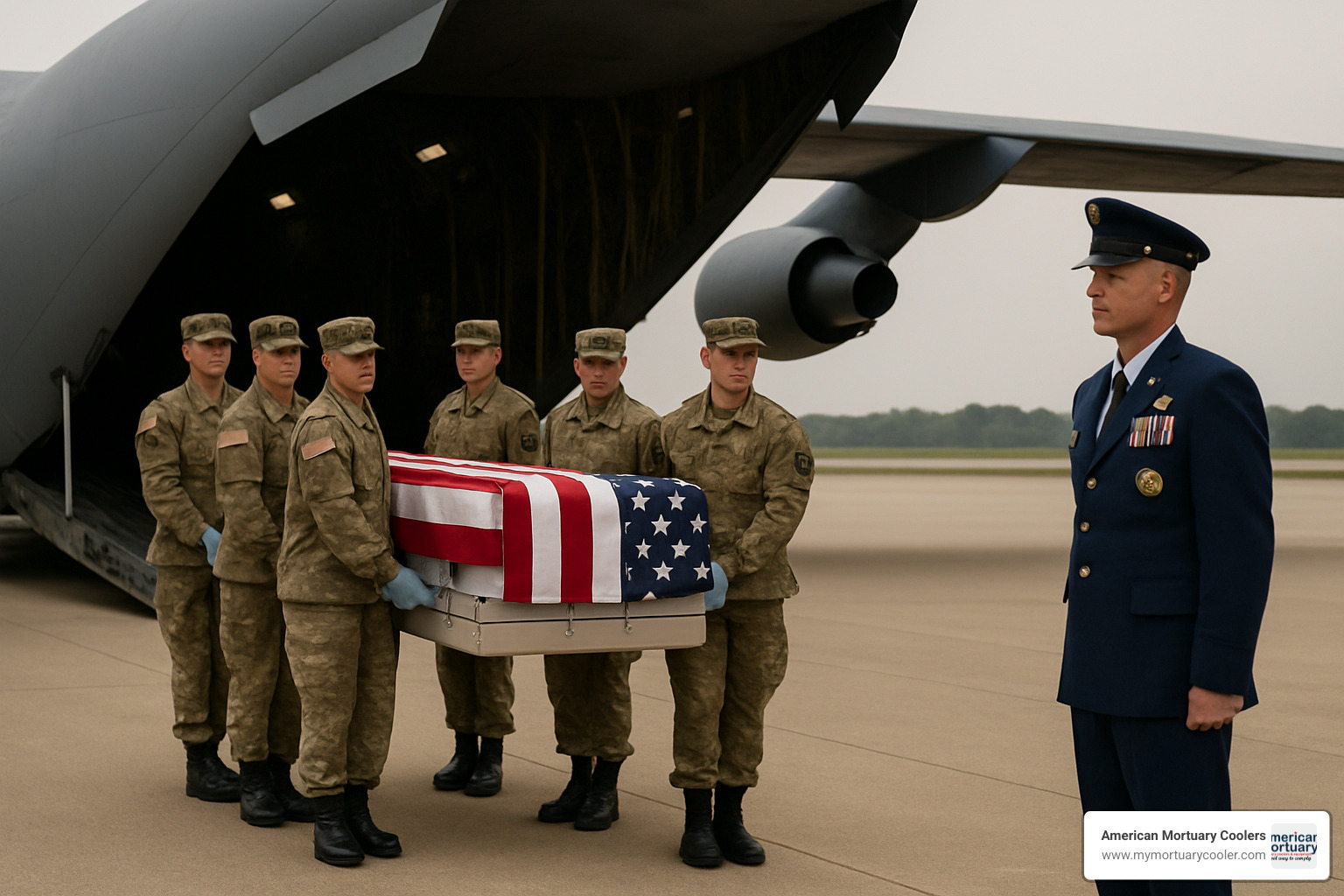
Every family receives a dedicated Casualty Assistance Officer who serves as their primary guide through the entire process, explaining what to expect and helping with difficult decisions about attendance, media coverage, and funeral arrangements.
The Fisher House at Dover AFB specifically supports families attending dignified transfers, staffed by deployed active-duty airmen and Reservists who serve six-month rotations and receive intensive training in grief support.
Carry Team & Senior Leadership Responsibilities
The carry team performs perhaps the most visible role in a dignified transfer. Selected from the same branch of service as the fallen hero, these service members undergo rigorous training to perform their duties flawlessly.
Each movement is practiced until it becomes second nature. They master specific techniques for lifting, carrying, and placing the transfer case with perfect alignment. Despite the physical weight of the transfer case, their movements remain precise and dignified.
The appearance of the carry team must be impeccable, with uniforms carefully prepared according to exact military specifications.
Overseeing each dignified transfer is a senior ranking officer from the fallen service member's branch of service, symbolizing recognition of the sacrifice at the highest levels of military leadership.
Family Support Teams & Chaplaincy Care
When families arrive at Dover Air Force Base, they enter an environment specifically designed to support them. The family support system operates around the clock, ensuring families never face this journey alone unless they request privacy.
The support team includes a senior chaplain, staff chaplain, religious affairs airman, mental health technicians, and family life counselors. This comprehensive approach ensures that every aspect of a family's needs receives attention from a qualified professional.
These team members follow thoughtful guidelines when supporting grieving families. For families with children, they create child-friendly spaces and normalize different expressions of grief.
The Meditation Pavilion provides a peaceful sanctuary for reflection and prayer. When families request specific religious accommodations, the support team coordinates with appropriate religious leaders.
Specialized Training & Equipment Guidelines
The responsibility of conducting a dignified transfer requires specialized training that goes beyond standard military instruction.
Dover Air Force Base regularly conducts mass-fatality exercises to prepare teams for scenarios involving multiple casualties. These comprehensive training events help various departments practice seamless coordination.
Before beginning their rotations at the Fisher House, support airmen receive intensive training in grief support, cultural competency, and techniques for supporting children through grief.
The equipment used during a dignified transfer must meet exacting standards. Transfer cases are uniform in appearance, allowing for proper flag draping. Vehicles that transport remains are specially designated and maintained in pristine condition.
Inside the mortuary center, specialized equipment ensures the continued dignified handling of remains. Body-lift systems prevent strain on personnel while maintaining respectful movement of the deceased.
At American Mortuary Coolers, we provide high-quality refrigeration units that meet the exacting standards required for preserving remains with dignity.
Rights, Choices, and Cultural Considerations for Families
When a family loses a service member, they face numerous decisions during an overwhelming time of grief. The military has designed the dignified transfer process to honor families' wishes while maintaining dignity.
One significant choice involves media coverage. Since 2009, families have gained control over how their loved one's return is documented:
| Media Consent Option | What It Means | Public Access | Family Receives |
|---|---|---|---|
| Full Media Access | Media may record and publicly release footage | Yes - Public media can access and publish | DVD copy of the transfer |
| Limited Recording | Military documents for historical purposes only | No - But subject to FOIA requests | DVD copy of the transfer |
| No Recording | No photography or videography permitted | No - No visual record created | No visual record |
The military explains each option thoroughly, ensuring families understand the implications of their choice.
Cultural and religious traditions receive careful attention throughout the process. For Muslim families, this might mean ensuring remains face Mecca. For Jewish families, it often involves expedited procedures to honor religious burial timelines.
At American Mortuary Coolers, we've designed our equipment with these diverse needs in mind.
Media Coverage Policy & Family Control
The evolution of media coverage at Dover represents a significant change in how America honors its fallen. Before 2009, media were prohibited from documenting these arrivals. Today's policy places decision-making power with the families.
For those who choose public coverage, the military establishes respectful boundaries. Media representatives must remain in designated areas, capturing ceremonial aspects without intruding on private grief. Photographers focus on the flag-draped transfer case rather than on grieving loved ones.
The military publication Stars and Stripes often provides more contextual coverage than typical news outlets, focusing on the service member's life and contributions.
Even when families choose the "limited record" option, these images become part of military archives and may be subject to Freedom of Information Act requests years later.
Religious & Cultural Accommodations
The dignified transfer process accepts America's diverse cultural mix through thoughtful accommodations.
When a Muslim service member makes the ultimate sacrifice, the military can arrange for an imam to be present. Jewish families may request a rabbi to oversee traditional practices. Native American families might seek specific spiritual leaders for ceremonies.
Time-sensitive religious practices receive priority attention. Both Jewish and Islamic traditions emphasize prompt burial, often within 24 hours when possible. The military expedites procedures in these cases while never compromising dignity.
Language barriers receive equal consideration. The military provides professional interpreters for families with limited English proficiency, ensuring they fully understand their options.
For international families, the military can arrange travel logistics, recognizing that service members come from diverse backgrounds with loved ones across the globe.
Ongoing Resources After the Dignified Transfer
The dignified transfer marks just the beginning of a long journey for families. The military has developed a comprehensive support network that continues long after the ceremony at Dover concludes.
Casualty Assistance Officers remain assigned for up to a year or longer, helping with practical aspects of loss—coordinating funeral arrangements, explaining benefits, and completing necessary paperwork.
Financial support comes through programs like the Survivor Benefit Plan. Emotional healing receives equal attention through resources like the Tragedy Assistance Program for Survivors (TAPS), which connects families with others who truly understand their loss.
Professional bereavement counseling remains available through military and Veterans Affairs facilities, as well as through civilian providers who accept TRICARE.
Challenges, Controversies, and Notable Dignified Transfers
Behind the solemn choreography of the dignified transfer process lies a history marked by both reverence and debate. These transfers have reflected America's complex relationship with war, sacrifice, and how we honor those who've given everything.
The question of media access has been a significant point of contention. From 1991 to 2009, Americans rarely saw images of flag-draped transfer cases returning to Dover. The 2009 policy change—putting families in control of media access—attempted to balance transparency with respect for grief.
Certain dignified transfers have captured national attention. The August 2021 transfer of the "Fallen 13" from the Kabul airport attack stands out not only for its tragedy but for the controversy that followed when some family members expressed disappointment with President Biden's conduct during the ceremony.
Similarly, when President Obama attended the August 2011 transfer for 38 U.S. and Afghan personnel killed in a helicopter crash, the event briefly united Americans in mourning while highlighting divisions about the war itself.
The April 2009 transfer of Specialist Israel Candelaria Mejias marked a historic turning point as the first conducted under the new media policy.
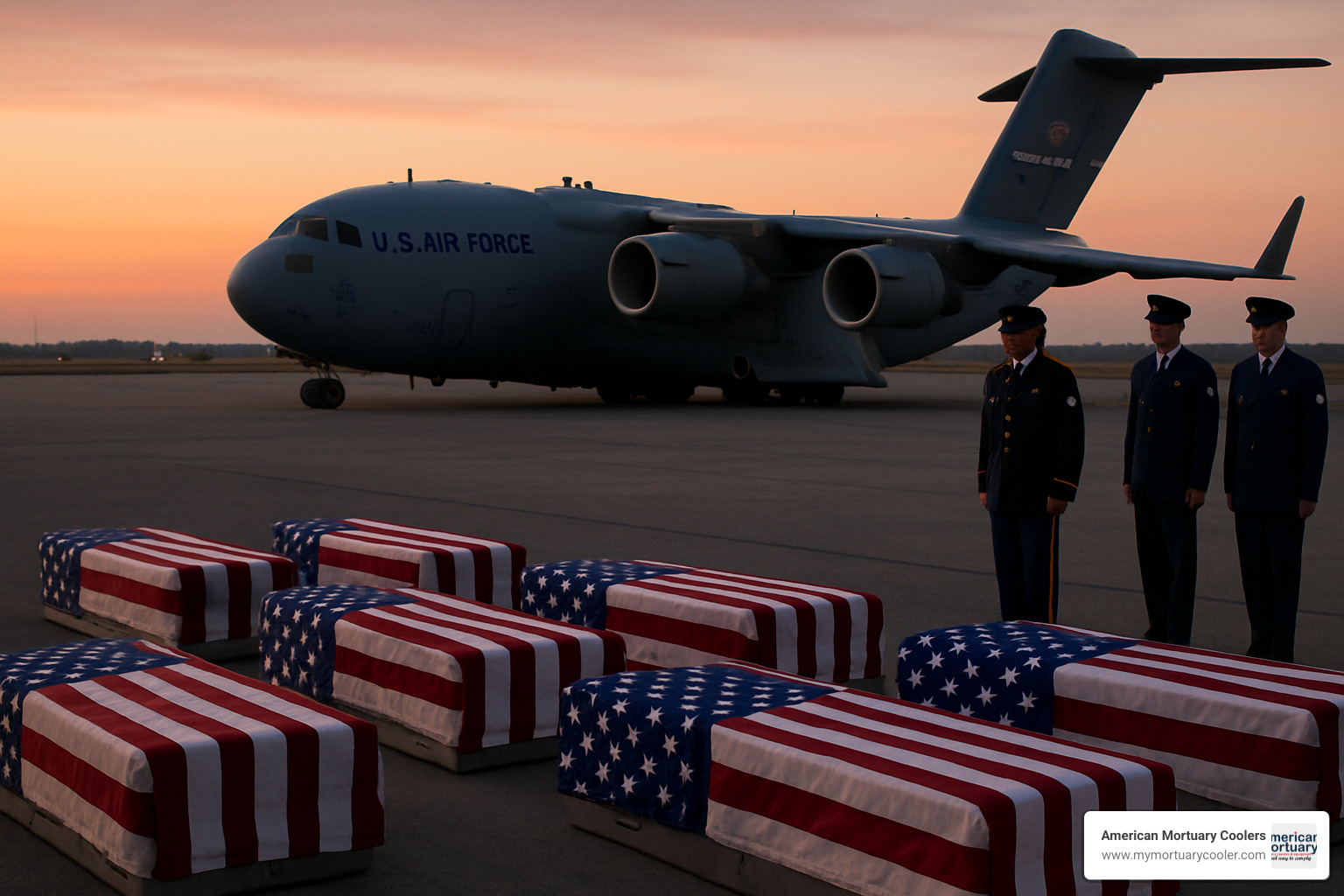
Media-Policy Evolution & Public Perception
Before 1991, media could document these solemn arrivals. The Bush administration's decision to ban media coverage during the Gulf War marked a significant shift that continued for nearly two decades.
When Defense Secretary Robert Gates announced the policy change in 2009, he acknowledged the delicate balance required: "We should not presume to make that decision for them," he said of the families.
This policy change coincided with the rise of social media. Today's Gold Star families have platforms to share personal stories, challenge official narratives, and advocate for how they believe their loved ones should be honored.
When The Sacramento Bee published intimate portraits of the families of the Fallen 13 from Kabul, readers connected with individual stories rather than just statistics.
Lessons Learned & Continuous Improvement
The dignified transfer process reflects years of thoughtful refinement and a willingness to listen to those most affected—the families.
The language used in family briefings has evolved significantly. Today's scripts use clearer, more compassionate language that better helps families understand what to expect.
The physical spaces for families have transformed dramatically. The Center for Families of the Fallen, which opened in 2010, represented a quantum leap in family support.
Cultural sensitivity has become increasingly central to the process. Support personnel now receive specialized training in diverse religious and cultural traditions.
Equipment improvements have played their part too. At American Mortuary Coolers, we've seen how advances in mortuary care technology support this mission of dignity. Our custom-built coolers incorporate precise temperature control and energy efficiency while maintaining the highest standards of respect.
Frequently Asked Questions about the Dignified Transfer
What happens if a family cannot travel to Dover?
Life's realities sometimes prevent families from traveling to Dover Air Force Base to witness their loved one's dignified transfer. The military understands and has created thoughtful alternatives.
Your assigned Casualty Assistance Officer becomes your lifeline to the process, providing real-time updates about when the aircraft has landed and when the transfer is complete.
Depending on circumstances and available equipment, the military may arrange secure video transmission of the transfer. If you've given consent for recording, you'll receive a DVD regardless of whether you attended.
The military understands that attendance isn't always possible. What matters most is that you feel supported and connected to this significant moment in your loved one's journey home.
Can remains be accompanied straight home instead of Dover?
All U.S. service members who die in a theater of operations must first come to Dover Air Force Base. This requirement exists because the Charles C. Carson Center for Mortuary Affairs performs essential functions including positive identification, professional preparation, and proper documentation.
However, once these necessary procedures are complete, your loved one won't travel alone. A military escort—typically someone who served alongside your family member—accompanies the remains all the way to your chosen funeral home.
For families with religious requirements calling for expedited burial, the military works diligently to accelerate processing while maintaining all necessary standards of dignity and care.
How long until the service member is returned for hometown services?
Most fallen service members return to their hometowns within 3 to 7 days after the dignified transfer at Dover. Several factors can influence this timeline:
- The identification process varies in complexity depending on circumstances
- Preparation requirements differ based on the condition of remains and family wishes
- Religious considerations may expedite the timeline
- Family preferences regarding funeral arrangements shape the timeline
- Transportation logistics must be carefully coordinated
Throughout this waiting period, your Casualty Assistance Officer serves as your direct connection to the process, providing updates and answering questions as they arise.
Conclusion & Next Steps
The dignified transfer process stands as a powerful testament to our nation's unwavering commitment to those who've made the ultimate sacrifice. It's not just a procedure—it's our country's promise that every fallen hero returns home with the honor and respect they've earned through their service.
For families walking the difficult path of grief, understanding this process often provides a small measure of comfort during an otherwise overwhelming time. There's something deeply meaningful about knowing your loved one is being cared for with such meticulous attention and profound respect.
At American Mortuary Coolers, we feel deeply honored to support this sacred mission through our mortuary refrigeration equipment. Based in our Tennessee manufacturing facility, we build custom coolers that help maintain the integrity and dignity of remains during those critical hours and days following the dignified transfer. We deliver these solutions across the contiguous 48 states, ensuring that funeral homes and military facilities have access to equipment that meets the highest standards.
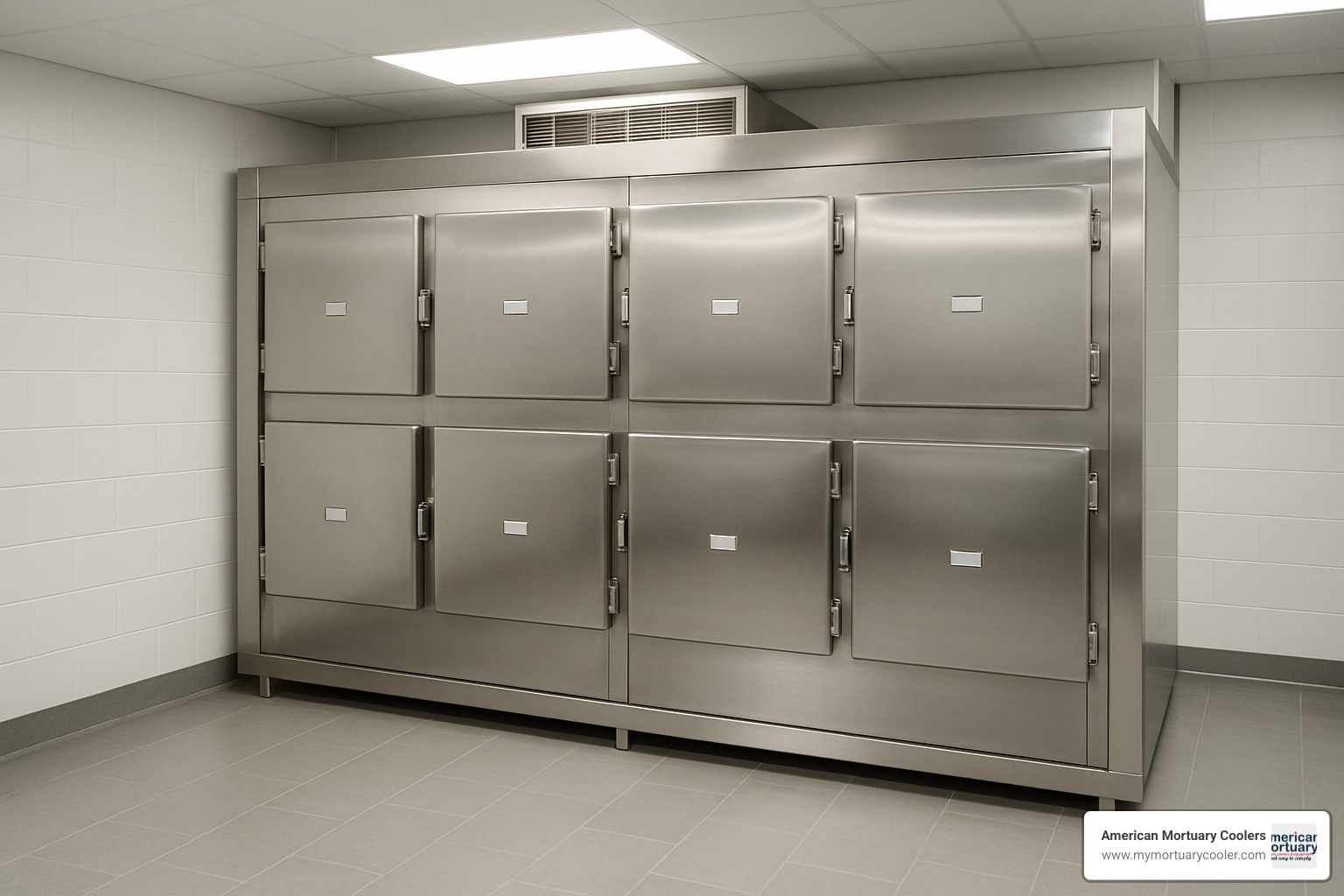
The values that guide our work—quality, respect, and dignity—mirror those embodied in the dignified transfer process itself. We understand that our equipment, while just one piece of a larger picture, plays a vital role in ensuring fallen heroes receive the utmost care as they begin their journey home.

If you'd like to learn more about our mortuary coolers and how they support dignified care, please visit our website or reach out to our team directly. We're here to provide compassionate solutions that honor both the fallen and the families who love them.
The dignified transfer represents more than just a movement of remains—it embodies our collective promise that no service member's sacrifice will ever be taken lightly, and that each will always return home with the honor they deserve.


















